KIA AMANTI 2009 Service Manual
Manufacturer: KIA, Model Year: 2009, Model line: AMANTI, Model: KIA AMANTI 2009Pages: 321, PDF Size: 23.77 MB
Page 41 of 321

329
Knowing your vehicle
Storing and recalling with trans-
mitterStoring with the transmitterTurn the ignition switch to LOCK from ON
and lock all the doors using the transmit-
ter. The seat and outside rearview mirror
positions will be stored in the system
memory.
Driver’s position recalling with trans-mitterUnlock the door with the transmitter,
positions stored in the system memory
will be recalled automatically.
If using two transmitters, recalling times
may vary because stored positions in
each transmitter may be different.
Example) If doors are locked with trans-
mitter A and unlocked with transmitter B,
the positions memorized when unlocked
with transmitter B will be recalled and
may take slightly longer than if unlocked
with transmitter A.
Page 42 of 321
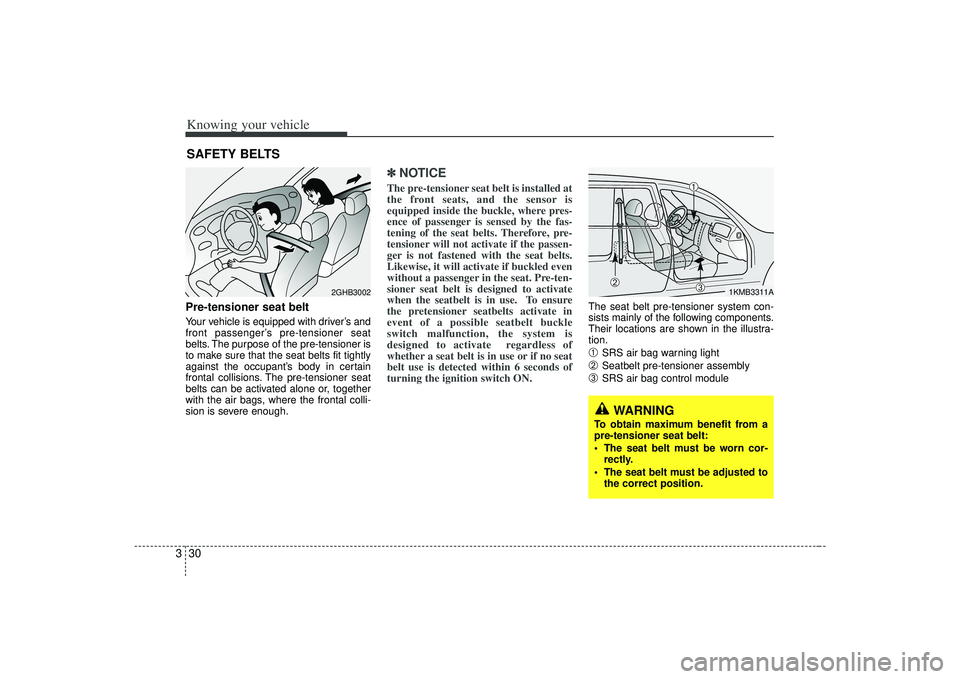
Knowing your vehicle30
3
WARNING
To obtain maximum benefit from a
pre-tensioner seat belt:
The seat belt must be worn cor-
rectly.
The seat belt must be adjusted to the correct position.
Pre-tensioner seat beltYour vehicle is equipped with driver’s and
front passenger’s pre-tensioner seat
belts. The purpose of the pre-tensioner is
to make sure that the seat belts fit tightly
against the occupant’s body in certain
frontal collisions. The pre-tensioner seat
belts can be activated alone or, together
with the air bags, where the frontal colli-
sion is severe enough.
✽ ✽ NOTICEThe pre-tensioner seat belt is installed at
the front seats, and the sensor is
equipped inside the buckle, where pres-
ence of passenger is sensed by the fas-
tening of the seat belts. Therefore, pre-
tensioner will not activate if the passen-
ger is not fastened with the seat belts.
Likewise, it will activate if buckled even
without a passenger in the seat. Pre-ten-
sioner seat belt is designed to activate
when the seatbelt is in use. To ensure
the pretensioner seatbelts activate in
event of a possible seatbelt buckle
switch malfunction, the system is
designed to activate regardless of
whether a seat belt is in use or if no seat
belt use is detected within 6 seconds of
turning the ignition switch ON.
The seat belt pre-tensioner system con-
sists mainly of the following components.
Their locations are shown in the illustra-
tion.➀
SRS air bag warning light
➁
Seatbelt pre-tensioner assembly
➂
SRS air bag control module
SAFETY BELTS
2GHB3002
1KMB3311A
➀
➁
➂
Page 43 of 321
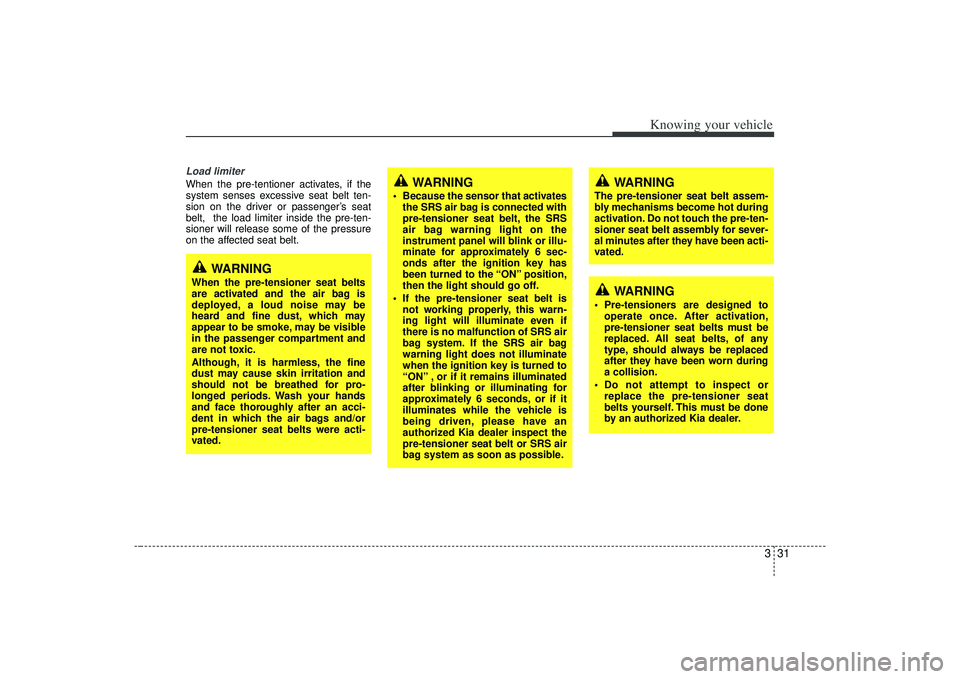
331
Knowing your vehicle
Load limiter When the pre-tentioner activates, if the
system senses excessive seat belt ten-
sion on the driver or passenger’s seat
belt, the load limiter inside the pre-ten-
sioner will release some of the pressure
on the affected seat belt.
WARNING
Pre-tensioners are designed tooperate once. After activation,
pre-tensioner seat belts must be
replaced. All seat belts, of any
type, should always be replaced
after they have been worn during
a collision.
Do not attempt to inspect or replace the pre-tensioner seat
belts yourself. This must be done
by an authorized Kia dealer.
WARNING
The pre-tensioner seat belt assem-
bly mechanisms become hot during
activation. Do not touch the pre-ten-
sioner seat belt assembly for sever-
al minutes after they have been acti-
vated.
WARNING
Because the sensor that activatesthe SRS air bag is connected with
pre-tensioner seat belt, the SRS
air bag warning light on the
instrument panel will blink or illu-
minate for approximately 6 sec-
onds after the ignition key has
been turned to the “ON” position,
then the light should go off.
If the pre-tensioner seat belt is not working properly, this warn-
ing light will illuminate even if
there is no malfunction of SRS air
bag system. If the SRS air bag
warning light does not illuminate
when the ignition key is turned to
“ON” , or if it remains illuminated
after blinking or illuminating for
approximately 6 seconds, or if it
illuminates while the vehicle is
being driven, please have an
authorized Kia dealer inspect the
pre-tensioner seat belt or SRS air
bag system as soon as possible.
WARNING
When the pre-tensioner seat belts
are activated and the air bag is
deployed, a loud noise may be
heard and fine dust, which may
appear to be smoke, may be visible
in the passenger compartment and
are not toxic.
Although, it is harmless, the fine
dust may cause skin irritation and
should not be breathed for pro-
longed periods. Wash your hands
and face thoroughly after an acci-
dent in which the air bags and/or
pre-tensioner seat belts were acti-
vated.
Page 44 of 321
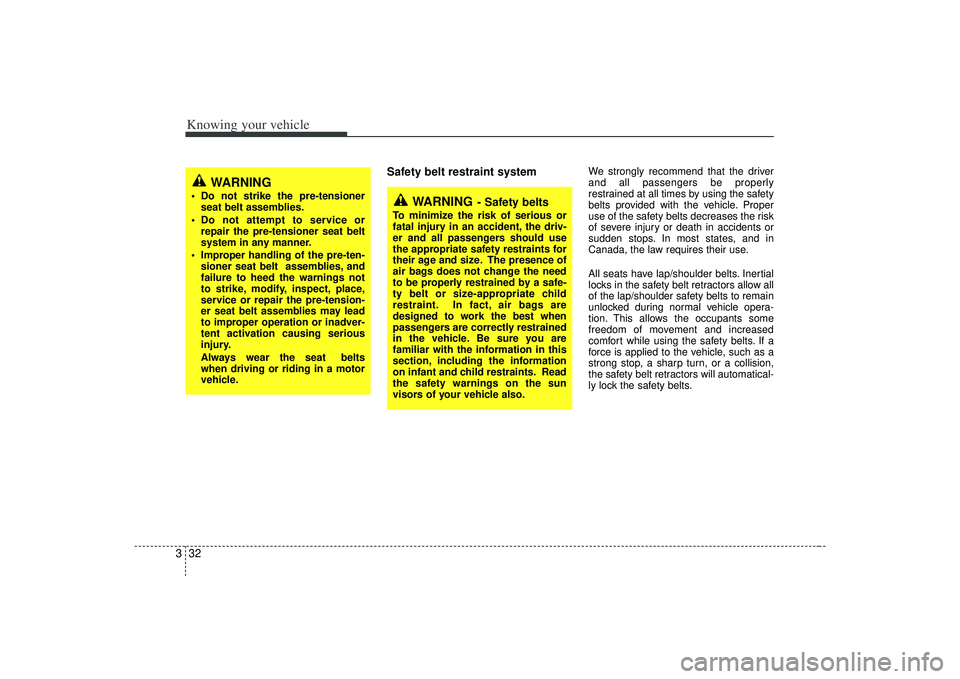
Knowing your vehicle32
3
Safety belt restraint system
We strongly recommend that the driver
and all passengers be properly
restrained at all times by using the safety
belts provided with the vehicle. Proper
use of the safety belts decreases the risk
of severe injury or death in accidents or
sudden stops. In most states, and in
Canada, the law requires their use.
All seats have lap/shoulder belts. Inertial
locks in the safety belt retractors allow all
of the lap/shoulder safety belts to remain
unlocked during normal vehicle opera-
tion. This allows the occupants some
freedom of movement and increased
comfort while using the safety belts. If a
force is applied to the vehicle, such as a
strong stop, a sharp turn, or a collision,
the safety belt retractors will automatical-
ly lock the safety belts.
WARNING
Do not strike the pre-tensioner
seat belt assemblies.
Do not attempt to service or repair the pre-tensioner seat belt
system in any manner.
Improper handling of the pre-ten- sioner seat belt assemblies, and
failure to heed the warnings not
to strike, modify, inspect, place,
service or repair the pre-tension-
er seat belt assemblies may lead
to improper operation or inadver-
tent activation causing serious
injury.
Always wear the seat belts
when driving or riding in a motor
vehicle.
WARNING
- Safety belts
To minimize the risk of serious or
fatal injury in an accident, the driv-
er and all passengers should use
the appropriate safety restraints for
their age and size. The presence of
air bags does not change the need
to be properly restrained by a safe-
ty belt or size-appropriate child
restraint. In fact, air bags are
designed to work the best when
passengers are correctly restrained
in the vehicle. Be sure you are
familiar with the information in this
section, including the information
on infant and child restraints. Read
the safety warnings on the sun
visors of your vehicle also.
Page 45 of 321
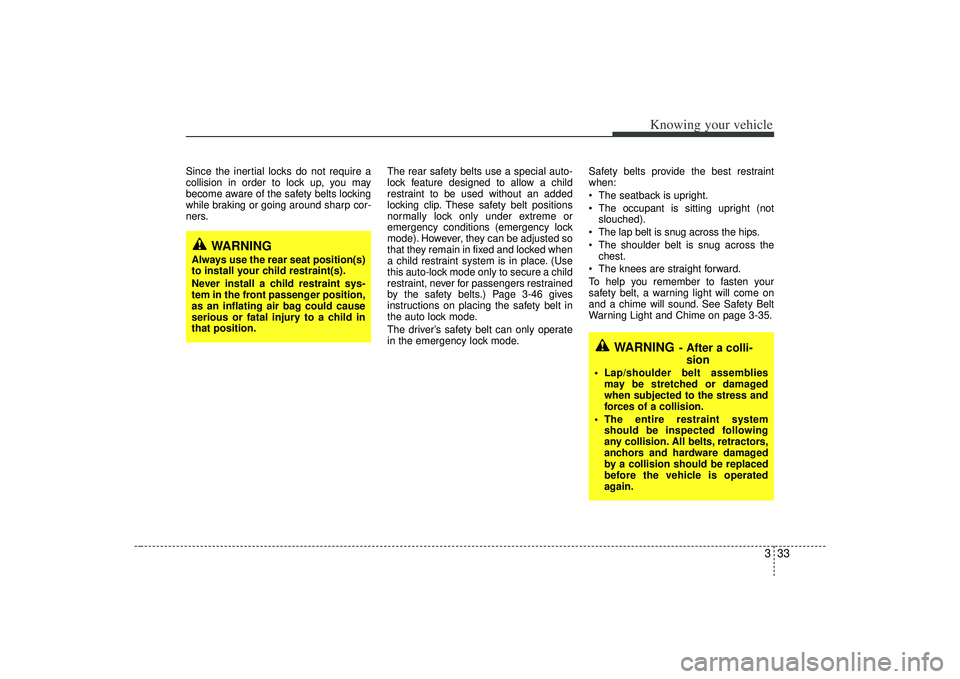
333
Knowing your vehicle
Since the inertial locks do not require a
collision in order to lock up, you may
become aware of the safety belts locking
while braking or going around sharp cor-
ners.The rear safety belts use a special auto-
lock feature designed to allow a child
restraint to be used without an added
locking clip. These safety belt positions
normally lock only under extreme or
emergency conditions (emergency lock
mode). However, they can be adjusted so
that they remain in fixed and locked when
a child restraint system is in place. (Use
this auto-lock mode only to secure a child
restraint, never for passengers restrained
by the safety belts.) Page 3-46 gives
instructions on placing the safety belt in
the auto lock mode.
The driver’s safety belt can only operate
in the emergency lock mode.Safety belts provide the best restraint
when:
The seatback is upright.
The occupant is sitting upright (not
slouched).
The lap belt is snug across the hips.
The shoulder belt is snug across the chest.
The knees are straight forward.
To help you remember to fasten your
safety belt, a warning light will come on
and a chime will sound. See Safety Belt
Warning Light and Chime on page 3-35.
WARNING
Always use the rear seat position(s)
to install your child restraint(s).
Never install a child restraint sys-
tem in the front passenger position,
as an inflating air bag could cause
serious or fatal injury to a child in
that position.
WARNING
- After a colli- sion
Lap/shoulder belt assemblies
may be stretched or damaged
when subjected to the stress and
forces of a collision.
The entire restraint system should be inspected following
any collision. All belts, retractors,
anchors and hardware damaged
by a collision should be replaced
before the vehicle is operated
again.
Page 46 of 321
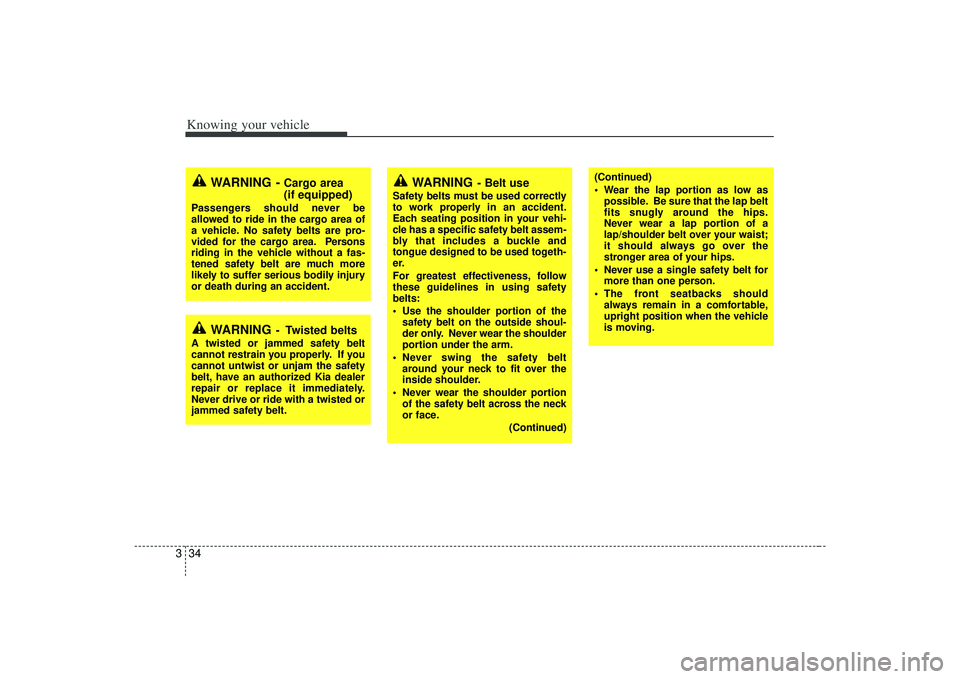
Knowing your vehicle34
3
WARNING -
Cargo area
(if equipped)
Passengers should never be
allowed to ride in the cargo area of
a vehicle. No safety belts are pro-
vided for the cargo area. Persons
riding in the vehicle without a fas-
tened safety belt are much more
likely to suffer serious bodily injury
or death during an accident.
WARNING
- Twisted belts
A twisted or jammed safety belt
cannot restrain you properly. If you
cannot untwist or unjam the safety
belt, have an authorized Kia dealer
repair or replace it immediately.
Never drive or ride with a twisted or
jammed safety belt.
WARNING
- Belt use
Safety belts must be used correctly
to work properly in an accident.
Each seating position in your vehi-
cle has a specific safety belt assem-
bly that includes a buckle and
tongue designed to be used togeth-
er.
For greatest effectiveness, follow
these guidelines in using safety
belts:
Use the shoulder portion of the
safety belt on the outside shoul-
der only. Never wear the shoulder
portion under the arm.
Never swing the safety belt around your neck to fit over the
inside shoulder.
Never wear the shoulder portion of the safety belt across the neck
or face.
(Continued)
(Continued)
Wear the lap portion as low aspossible. Be sure that the lap belt
fits snugly around the hips.
Never wear a lap portion of a
lap/shoulder belt over your waist;
it should always go over the
stronger area of your hips.
Never use a single safety belt for more than one person.
The front seatbacks should always remain in a comfortable,
upright position when the vehicle
is moving.
Page 47 of 321
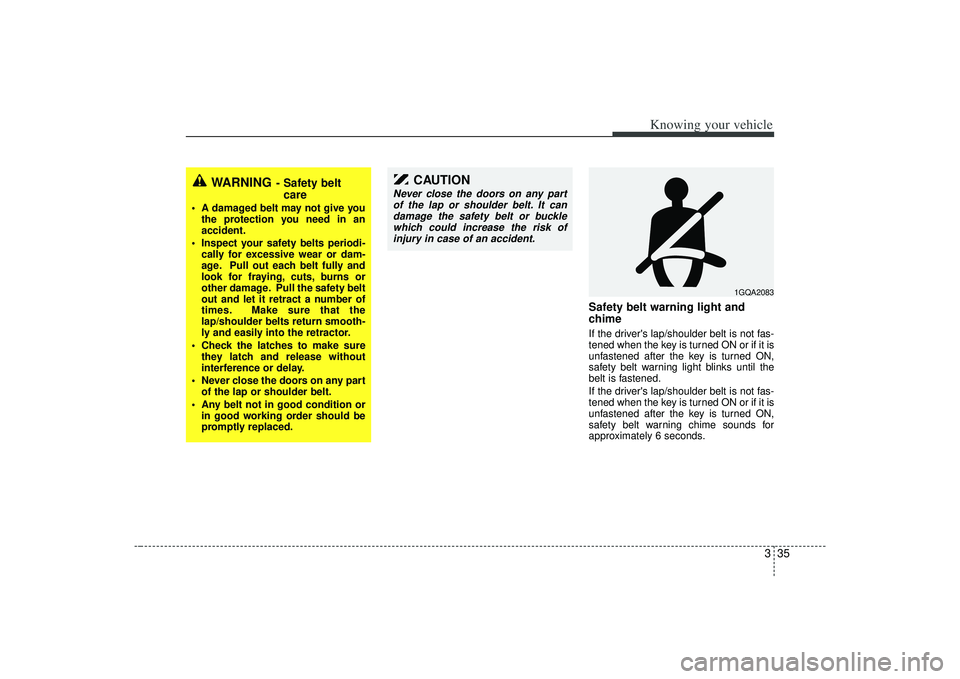
335
Knowing your vehicle
Safety belt warning light and
chimeIf the driver's lap/shoulder belt is not fas-
tened when the key is turned ON or if it is
unfastened after the key is turned ON,
safety belt warning light blinks until the
belt is fastened.
If the driver's lap/shoulder belt is not fas-
tened when the key is turned ON or if it is
unfastened after the key is turned ON,
safety belt warning chime sounds for
approximately 6 seconds.
1GQA2083
WARNING
- Safety beltcare
A damaged belt may not give you
the protection you need in an
accident.
Inspect your safety belts periodi- cally for excessive wear or dam-
age. Pull out each belt fully and
look for fraying, cuts, burns or
other damage. Pull the safety belt
out and let it retract a number of
times. Make sure that the
lap/shoulder belts return smooth-
ly and easily into the retractor.
Check the latches to make sure they latch and release without
interference or delay.
Never close the doors on any part of the lap or shoulder belt.
Any belt not in good condition or in good working order should be
promptly replaced.
CAUTION
Never close the doors on any partof the lap or shoulder belt. It candamage the safety belt or buckle which could increase the risk ofinjury in case of an accident.
Page 48 of 321
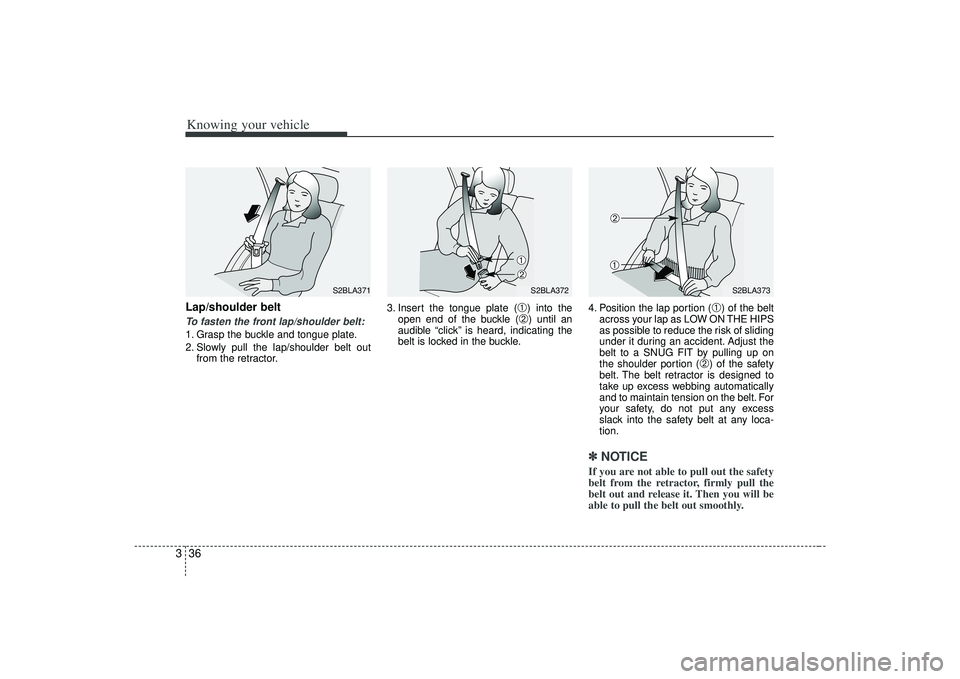
Knowing your vehicle36
3Lap/shoulder beltTo fasten the front lap/shoulder belt:1. Grasp the buckle and tongue plate.
2. Slowly pull the lap/shoulder belt out
from the retractor. 3. Insert the tongue plate (
➀) into the
open end of the buckle (➁) until an
audible “click” is heard, indicating the
belt is locked in the buckle. 4. Position the lap portion (
➀) of the belt
across your lap as LOW ON THE HIPS
as possible to reduce the risk of sliding
under it during an accident. Adjust the
belt to a SNUG FIT by pulling up on
the shoulder portion (
➁) of the safety
belt. The belt retractor is designed to
take up excess webbing automatically
and to maintain tension on the belt. For
your safety, do not put any excess
slack into the safety belt at any loca-
tion.
✽ ✽ NOTICEIf you are not able to pull out the safety
belt from the retractor, firmly pull the
belt out and release it. Then you will be
able to pull the belt out smoothly.
S2BLA371
S2BLA372
S2BLA373
➀➁
➀➁
Page 49 of 321
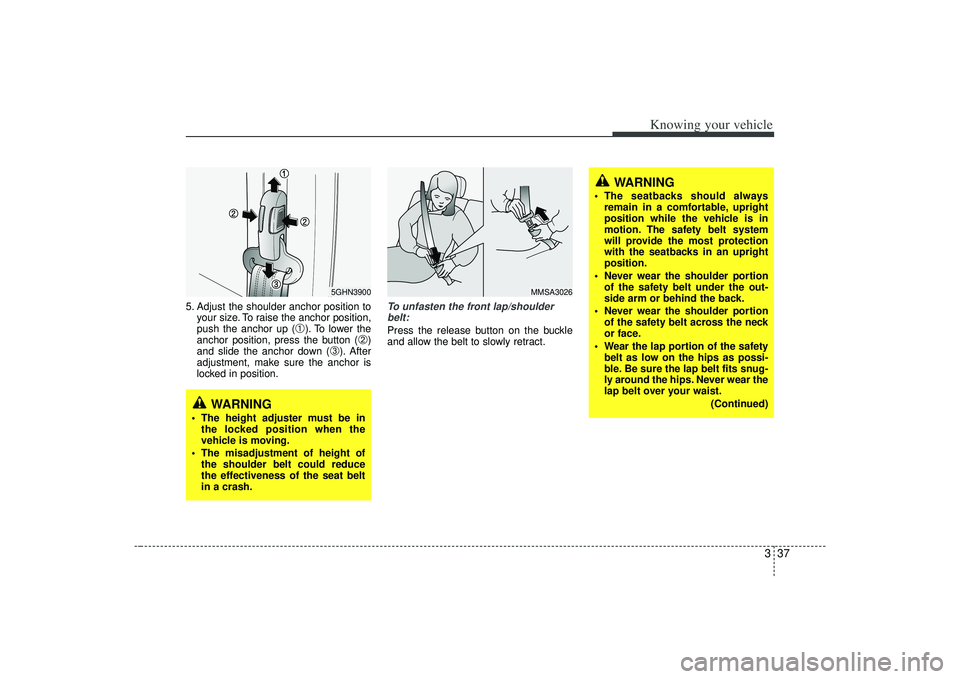
337
Knowing your vehicle
5. Adjust the shoulder anchor position toyour size. To raise the anchor position,
push the anchor up (
➀). To lower the
anchor position, press the button (
➁)
and slide the anchor down (
➂). After
adjustment, make sure the anchor is
locked in position.
To unfasten the front lap/shoulder belt:Press the release button on the buckle
and allow the belt to slowly retract.
MMSA3026
5GHN3900
WARNING
The height adjuster must be in the locked position when the
vehicle is moving.
The misadjustment of height of the shoulder belt could reduce
the effectiveness of the seat belt
in a crash.
WARNING
The seatbacks should alwaysremain in a comfortable, upright
position while the vehicle is in
motion. The safety belt system
will provide the most protection
with the seatbacks in an upright
position.
Never wear the shoulder portion of the safety belt under the out-
side arm or behind the back.
Never wear the shoulder portion of the safety belt across the neck
or face.
Wear the lap portion of the safety belt as low on the hips as possi-
ble. Be sure the lap belt fits snug-
ly around the hips. Never wear the
lap belt over your waist.
(Continued)
Page 50 of 321
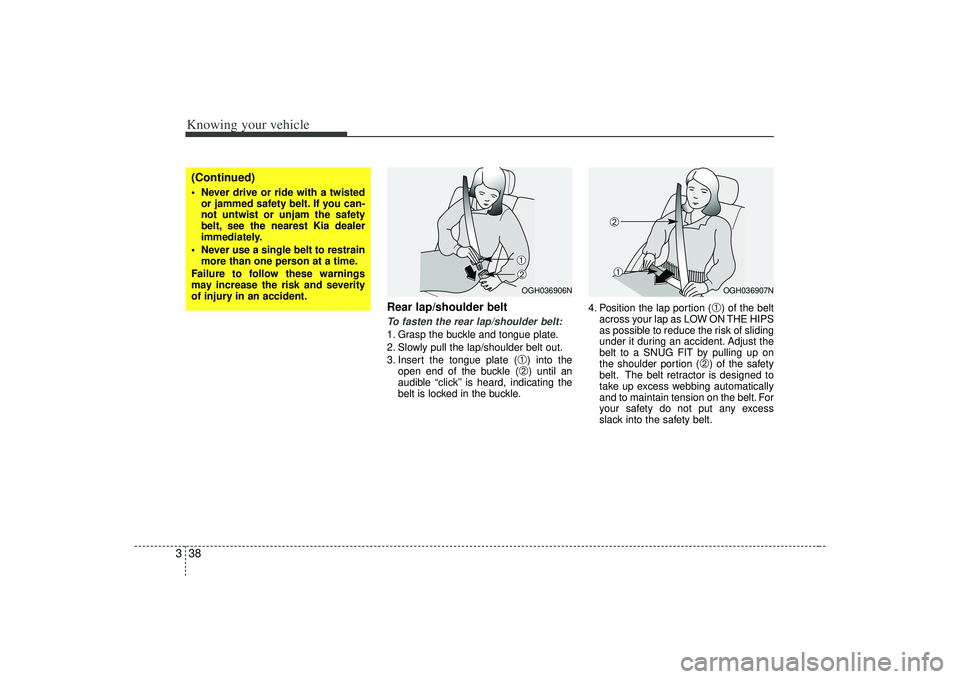
Knowing your vehicle38
3
Rear lap/shoulder belt To fasten the rear lap/shoulder belt:1. Grasp the buckle and tongue plate.
2. Slowly pull the lap/shoulder belt out.
3. Insert the tongue plate (
➀) into the
open end of the buckle (➁) until an
audible “click’’ is heard, indicating the
belt is locked in the buckle. 4. Position the lap portion (
➀) of the belt
across your lap as LOW ON THE HIPS
as possible to reduce the risk of sliding
under it during an accident. Adjust the
belt to a SNUG FIT by pulling up on
the shoulder portion (
➁) of the safety
belt. The belt retractor is designed to
take up excess webbing automatically
and to maintain tension on the belt. For
your safety do not put any excess
slack into the safety belt.
(Continued) Never drive or ride with a twisted or jammed safety belt. If you can-
not untwist or unjam the safety
belt, see the nearest Kia dealer
immediately.
Never use a single belt to restrain more than one person at a time.
Failure to follow these warnings
may increase the risk and severity
of injury in an accident.
OGH036906N
OGH036907N
➀➁
➀➁